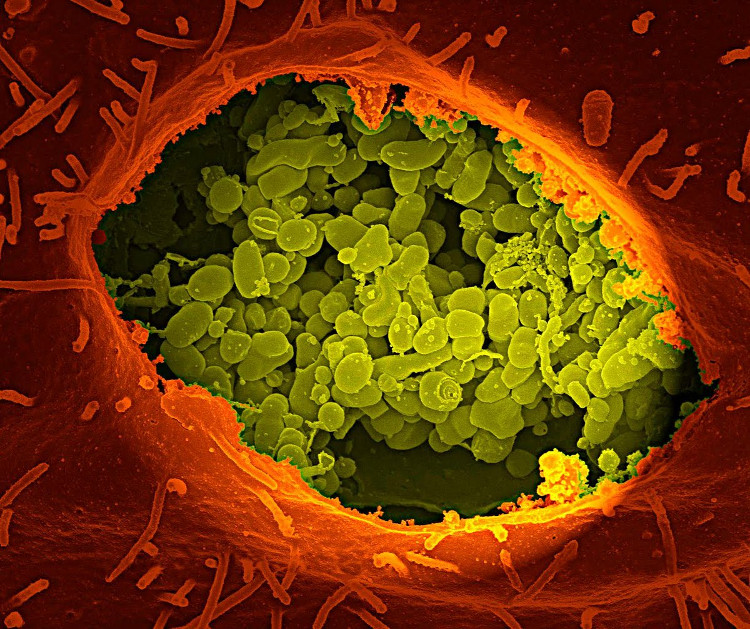How will NASA protect the Earth from
In the summer of 1957, mankind witnessed a terrible collision between a meteorite and the Earth, leaving a disastrous consequence for rural peoples of Pennsylvania: the invasion of moss-eating humans . Currently NASA and international organizations are working hard to prevent and prevent any similar threats that may occur in the future.

Biological pollution must be prevented both ways.
Biological pollution must be prevented both ways. Not only does it prevent foreign microorganisms from entering the Earth's surface (known as "reverse pollution" ), but the task is also to control not to let cells from Earth enter the space through. space exploration ship (known as "convenient pollution" ). For this reason, in 1958 the US National Academy of Sciences issued a decree requiring "scientists to conduct research on the moon as well as other planets with a careful and vigilant attitude to the journey to explore the universe will not leave serious consequences to hinder space missions later ".
In the following year, the Cosmic Research Council (COSPAR) was established and agreed that "all research and space exploration activities must be done carefully to ensure that Mars is not polluted. biology " before having any life-seeking behavior on this planet. These proposals were later drafted into law in 1967, with major countries such as the US, the Soviet Union and the United Kingdom signing the UN Aerospace Discovery Agreement.

These proposals were later drafted into law in 1967, with major countries such as the US, the Soviet Union and the United Kingdom signing the UN Aerospace Discovery Agreement.
Dr. Lucianne Walkowicz, working astronaut at the Adler Observatory and Chairman of the Space Biology section of the National Library of the United States, shared: "When it comes to protecting life on the "We need to think about preserving it not to affect future space missions." "When you bring a yacht to explore another planet (or even another species), you need to make sure you have enough knowledge about the habitat there. Be careful to avoid polluting the area. "
However, not every alien object that is discovered also requires the same level of caution. For example, entities such as Mercury and the Sun, which are completely non-existent in the development of biological cells, do not need to be prevented like Mars or the Moon, which is often subjected to Large radiation and extremely low heat levels. In fact, COSPAR has set up a 5-rung rating system for countries' space research agencies to rely on and design spacecraft accordingly:
- Level 1 : Planets are almost non-existent, such as Mercury
- Level 2 : The executions may have existed for a long time, but the possibility of biological pollution caused by Earth bacteria is extremely low, such as Venus and the Moon.
- Level 3 : Discovery missions include tracking and spinning around orbits, with a moderate level of biological pollution, such as Mars's Mars and Satellites Europa.
- Level 4 : Space exploration missions including landing on the surface or detection, the study site is similar to Level 3, but is divided into smaller items depending on the specific planetary surface What is the exact purpose of landing a yacht.
- Level 5 : A dangerous level, alerting a high risk of biological pollution. The "emergency prevention of possible impacts during the return of the spacecraft is required, the destruction of all equipment in direct contact with the source of contamination and the prevention of any unpasteurized material. Anything allowed to return to the Earth's surface ".
This planetary level alarm system is designed to minimize the negative impact of both "pollution pollution" and "reverse pollution". "We need to protect the Earth's biosphere because of the life of a range of existing organisms , " Walkowicz said. "We should only allow the use of samples that do not endanger our planet and benefit from laboratory research."
However, Dr. Rummel did not quite seem to be too concerned about this: "In my opinion, there is a great possibility that if robots explore the universe bring about something that exists in life then they It is also unlikely to be harmful ". According to him, often they are not equipped to withstand the pressure of cross-planet flights. "I have absolutely no idea what these entities need to survive, so the ability to bring them completely in a state of living is almost impossible."
To ensure that the spacecraft before being launched into orbit is carefully sterilized, OPP has relied on a traditional disinfection process called "Reducing bacteria at dry temperatures" (DHMR) . This method is interpreted as heating all the components that make up the spacecraft to a temperature of 110 degrees C for 47 hours continuously, or 125 degrees for 5 hours continuously, with a relative humidity of zero. First applied to the Viking expedition mission, this method proved to be extremely effective. They not only work to kill bacteria that cling to the surface of the hull, but also the space between the surfaces together, even interfering with the material inside. "That's why this is still the most widely used disinfection method , " Walkowicz explains.

NASA is working to research other methods to improve the effectiveness of DHMR.
However, this method is not without restrictions. It cannot disinfect the whole ship, because there are simply some special parts like electronic circuits, adhesives or parachutes when landing will be easily destroyed under the impact of heat. Therefore, NASA is working hard to study other methods to improve the effectiveness of DHMR, largely based on modern medical technologies.
NASA's Rocket Propulsion Laboratory is currently developing a new disinfection method called "Disinfection by using oxygen to evaporate phase by phase". When 140 ppm concentrated liquid oxygen solution at 1400 ppm water is obtained, a powerful antimicrobial agent is obtained. The biggest drawback of this method, however, is that it has never been tested on a large scale, such as for spacecraft. "It is still possible to experiment with each small part of the hull instead of the entire ship as expected , " Walkowicz said. But also be careful with the concentration of this solution. If the concentration exceeds 75 ppm, it will become toxic to human health.

The method of radioactive ionization is also a possible possibility.
Sterilization with ethylene oxide gas has also been taken into account, although Walkowicz cautions that it is a fairly explosive substance. The method of radioactive ionization is also a possible possibility. This was adopted by NASA when the beagle of the Beagle 2 could not be sterilized using conventional DHMR methods. Meanwhile, NASA's Mars Discovery Program is studying the idea of using electron beams , currently used to sterilize food, to apply to disinfection of spacecraft.
"We often send robotic detectors and I think that is something we can see in the first few Mars human involvement expeditions." Basically, astronauts will stay in or isolated in a giant block of metal and control the robot from afar to do other hands-on tasks. "In other words, instead of worrying about cleaning up the spacecraft later, design it to be as clean as possible, preferably from the beginning."
Walkowicz said that the requirements related to the protection of each planet's ecological environment should not be considered to be a hindrance to travelers' passions, but instead consider them invaluable assets of space travel industry."If you want to really discover the origin of life, want to take advantage of the value of Mars, satellites Europa or any other celestial body, you need to practice for yourself a habit of consciously protecting the environment. Head before doing the next steps. That will help science grow as you want. "
Franklin Roosevelt once said: "The only thing you should feel scared about is the fear of being there . " For this case, that fear is nothing more than epidemics of foreign origin in space.
- NASA started the plan to protect the Earth
- NASA's meteorite protection strategies
- '9-year-old Galaxy Guard' wrote a cover letter at NASA
- America uses nuclear weapons to protect the Earth from meteors
- NASA dismisses information that Earth will eradicate in September 2015
- The asteroid that once passed NASA is about to return
- This is how NASA will use it to protect chimpanzees
- The copper shield can protect the Earth from the solar storm
- NASA: It is okay to fight meteors, but ... lack of funds!
- Dust-producing asteroids can combat climate change on Earth
- Review NASA photos to see how terribly the Earth has changed
- NASA's beautiful picture of Earth
 Van Allen's belt and evidence that the Apollo 11 mission to the Moon was myth
Van Allen's belt and evidence that the Apollo 11 mission to the Moon was myth The levels of civilization in the universe (Kardashev scale)
The levels of civilization in the universe (Kardashev scale) Today Mars, the sun and the Earth are aligned
Today Mars, the sun and the Earth are aligned The Amazon owner announced a secret plan to build a space base for thousands of people
The Amazon owner announced a secret plan to build a space base for thousands of people